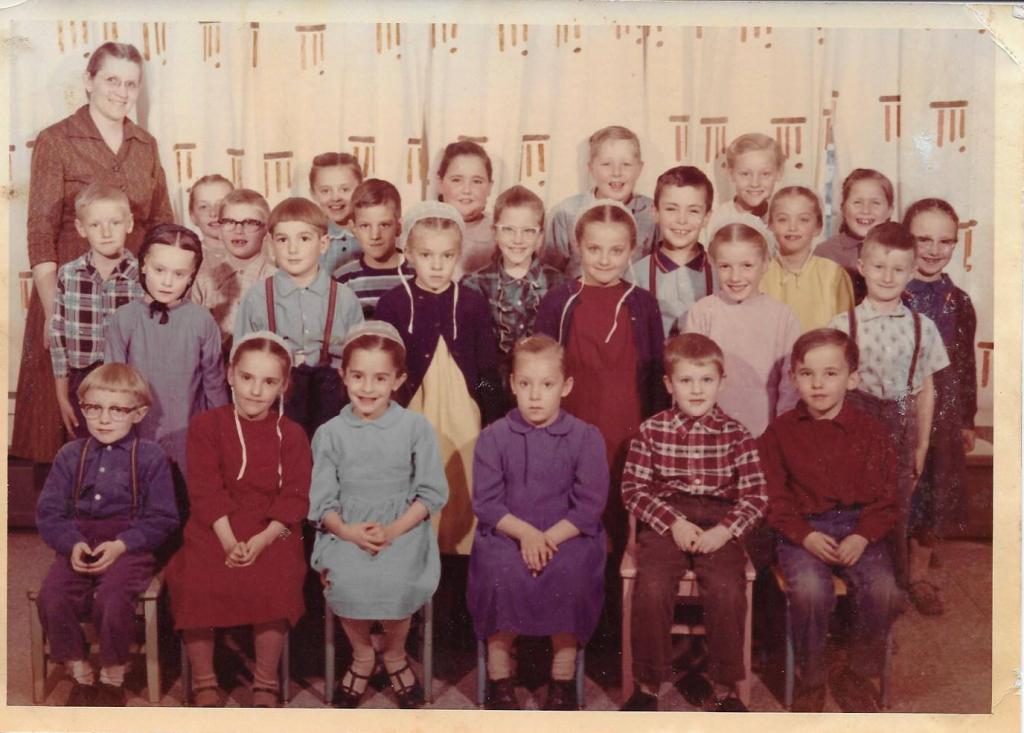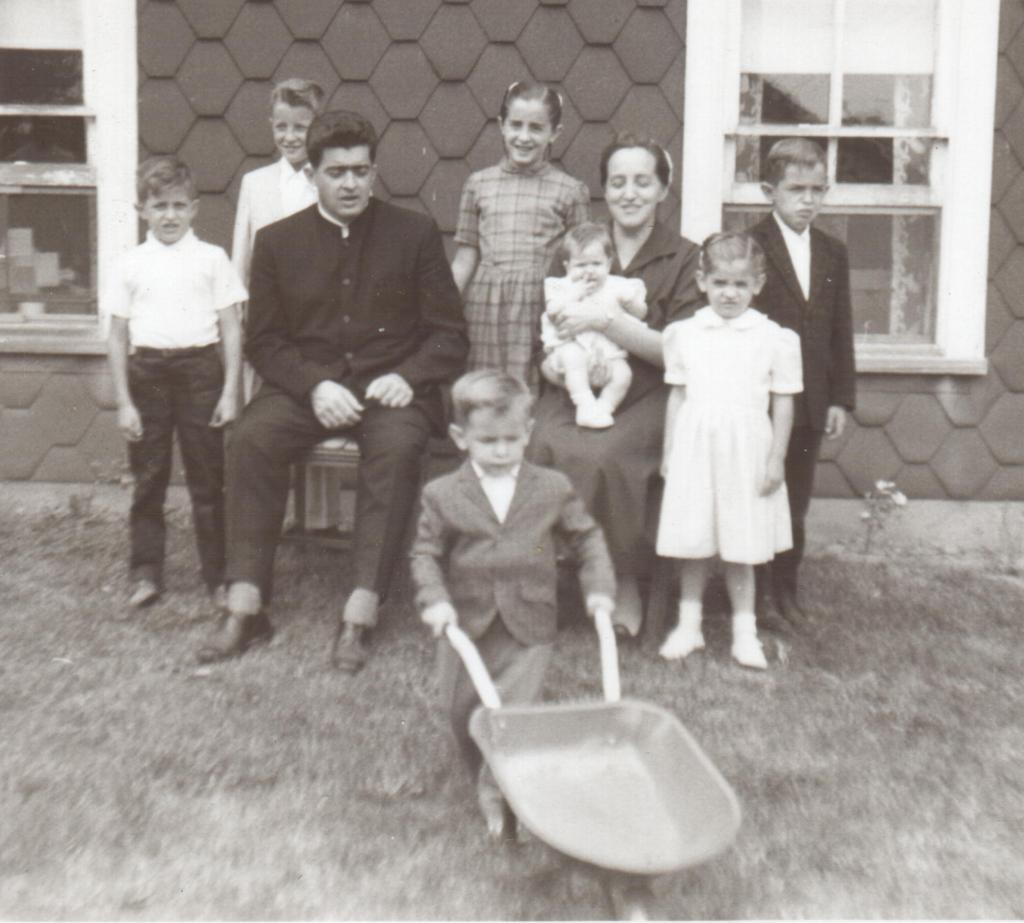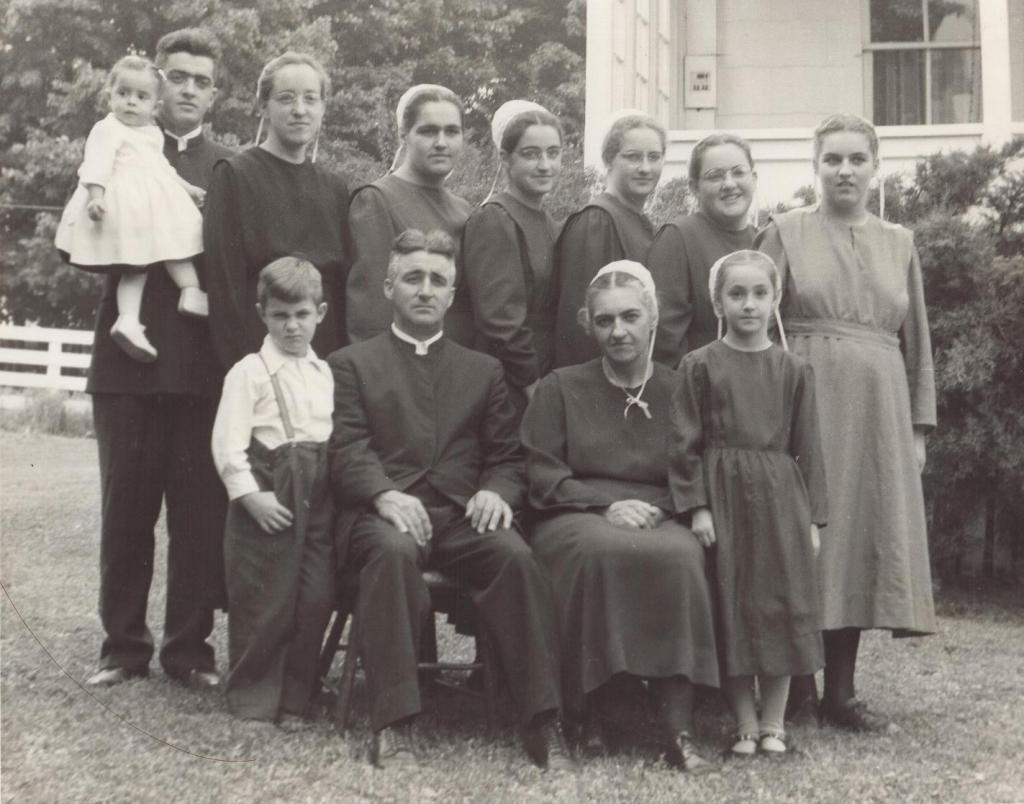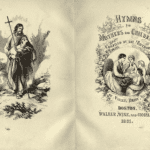I’m pleased to welcome my mother, Phyllis Miller Swartz, to the Anxious Bench. She has extensive teaching experience at middle schools and prisons in Ohio. She is also the author of Yoder School, just released by Cascadia House. It’s a memoir that traces the educational journey of a young conservative Mennonite schoolgirl from the Appalachian Mountains to gritty Flint, Michigan, to Amish country in Lancaster County, Pennsylvania, to the hippie hothouse of Antioch College. I know I’m biased, but this is a really compelling book.
—David
***
What was Yoder School?
Nicknamed “Dutch College,” Yoder was a public school, eight grades in three rooms. It was set upon a slope rising up from the Casselman River in one of the ranges of the Appalachian Mountains in western Maryland. But only the children of the plain people went there—Amish, Beachy, and Mennonite kids. I belonged to the Mennonites.
My classmates reminded me of the quilt on my bed at home. I liked the mixed-together patterns: the dark aproned dresses of the Amish girls beside the brighter dresses of the Mennonites, short hair of the Mennonite boys mixed with the longer Amish cuts like the hair of Noah Yoder, who sat across the aisle from me. His straw-colored hair looked as if his mom put a serving bowl on top of his head and then cut all the hair that hung beneath the bowl. I liked how his hair bounced when he ran to recess.

Your reflections begin with a three-room Amish schoolhouse, but they end with the hippie Antioch College. On one level, they couldn’t be more different. But you suggest that they had many similarities. How so?
At Yoder School time flowed and subjects merged into each other. My classmates and I couldn’t quite tell if we were working or playing or learning. We tramped across meadows and through woods to fill jars with flowers. And back at school, we pored over flower books to identify the hundred and fifty specimens we had found. We watched a monarch butterfly emerge from its cocoon and used math block towers to solve the puzzles of math. We counted out change in our classroom “store” and wrote our own books. No matter our ages, we read with the first grade or second or fifth, whichever level fit us best. At Yoder School, I could see that learning was full of wonder, so I decided to become a teacher.
And then we moved away—to Flint, Michigan. How, I often asked myself during those years, could I become a good teacher when I didn’t have one? Through junior high and high school and in classes at a community college, I kept searching for the enchantment I had found at Yoder School. And mostly not finding it. Not until I enrolled at Antioch College in Yellow Springs, Ohio.
When I walked into my first class, I didn’t see cape dresses and suspenders and head coverings. But I did see distinctive dress. I saw tattoos and body piercings in eyebrows and noses and lips and tongues. I saw purple hair and bare feet. And I saw headbands and flowers in hair so unkempt my grandma would have called it strubblig.
But in those classrooms in Yellow Springs, I found wonder once again. At Antioch students learned, not only in classes, but also outside classroom walls, spending 25 percent of their time in internships. We didn’t use No. 2 pencils to fill in little rectangles on bubble answer sheets. Instead, we researched and wrote papers and debated. Our professors didn’t give us grades, but they wrote narrative evaluations of our involvement in class. With this freedom, I became invested and set higher standards for my work than a professor would have set. Once again, I was curious. I wanted to know things.

What can your experiences as a child say about American Mennonite trajectories more broadly in the 1960s and 1970s?
I left the cloistered three-room Yoder School in the mountains of Western Maryland because my parents moved to Flint, Michigan. There I encountered fights, peace-loving hippies, race riots, and tried to keep from getting bullied for wearing a head covering to school. I didn’t have the perspective then that I was among others who were also the “quiet in the land” moving beyond the shelters of their own communities to follow a new missionary impulse. I only knew that I understood more about being a stranger in the land than I wanted to know—how it felt, for example, to wear a head covering to a school where no one had ever heard of a Mennonite. And I wondered about social issues I had never pondered before—what the church could do, for example, about racial tension and poverty. And I was puzzled by the two flavors of peace I saw—the turn-your-cheek kind I had been taught in Sunday school and the calls for peace from the flower children and the protestors of the Vietnam War.
I had a greater understanding, though, of how I fit into the historical trajectory of higher education. Sitting on the long bench at my grandma’s kitchen table during family meals, I had listened to stories about our family’s chain of learning. I’d heard how my great-grandpa taught himself English so well that people said they needed a dictionary to understand him when he preached, how my great-great grandpa had founded the subscription school that later became Yoder School, and how my grandpa four greats back had started a school in his home, saying, “The children must learn.”
Squished between my cousins on the bench and swirling gravy through my mashed potatoes, I’d think about how I, too, liked to learn. And I’d feel sorry for my mom and dad and grandparents, who had quit school for the church, even though they would have liked more schooling.
Now in the 1960s, the church let people go to school past seventh grade, all the way through high school and even to college. This is why my dad had gone to college, even though he had never gone to high school and even though he had three children and almost four and even though he milked 20 Jerseys every day to pay the rent and sold eggs door-to-door in the city to buy groceries. Like me, my dad liked to work with his mind more than with his hands.
And I recognized that it was both a privilege and a responsibility to be the first one in this chain of people to have known on my first day at Yoder School, that I could go straight through all the grades of school and through all the years of college to get a diploma. This might be hard, I often thought, but I need do this.

Can you share a brief excerpt from the book?
That summer, my father baptized me. This made public my association with God. With my baptism, I acknowledged that I would follow Jesus’s teachings in daily life, that I would bend my will to God’s will, to suffer so that later I would be in glory with God. And now was the time to start wearing a covering on my head, in accordance with the Apostle Paul’s words in I Corinthians 11. I won’t think about wearing this to school until fall, I promised myself each morning when I pinned my covering over my hair.
My first day to wear a covering to T.N. Lamb Junior High, I woke with a dread like I was going to one of the executions in the Martyrs’ Mirror. My brother James and I read the Martyrs’ Mirror with a fascinated horror. This heavy book, four inches thick, told the stories of over four thousand people who died because they refused to give up their beliefs about God. We read about two girls who were led to their executions with straw wreaths on their heads.
One girl whispered to the other, “Since the Lord Jesus wore a crown of thorns for us, why should we not wear these crowns of straw in honor of him?”
We read about bodies torn on the rack and gouged out eyes, and beheadings, and stories of people singing while they burned. These stories were proof to us that living for God brings people to suffering. And this could be true for us, too. Wearing a covering to T.N. Lamb Junior High wasn’t anything like being burned on a stake, but it sure felt like it.
I started off later than usual, on purpose. I wanted to arrive just as the school bell rang. I was conscious of each step I took toward school, feeling fortunate that I wasn’t meeting anyone I knew. Then I came to the smoking tree, just a block before school.
Usually when I came by that tree, twenty to thirty kids lounged under it taking their last drags before school. But it was late, so only about five kids still lingered, the smoky, blue haze much thinner than it would have been ten minutes before. As soon as Harold MacDonald saw me, he said, “What the heck?” But just then the warning bell rang. Harold and his buddies stomped out their cigarettes and hightailed it for school. And I hurried behind them, moving faster than I had all morning.
The day was everlasting, just like the day I kept Amos Beachy from getting a paddling so long ago at Yoder School. My friends raised their eyebrows when they saw me or simply asked, “What’s that?” I shaved my answer down to three words: for my church. I could see my teachers watching me. And the kids who didn’t know me so well just pointed and snickered. I kept my head high and raised my hand to answer questions in class. I looked everyone—my friends and everyone else—straight in the eye. . . .
You just retired after thirty years of teaching. How did this childhood incident shape your teaching methods?
School hurts. It’s a place where students get wounded. Rushed teachers make throw-away comments. And bullies pass their pain to others. Students are maligned for not having the right accent, the right shoes, the right hair. Or, they are ostracized for living on the wrong side of town or because the work is too hard for them . . . or too easy. And students are marginalized for their ethnicities.
My wounding came from being different—a country girl moved to the city with braids instead of a beehive hairdo, with skirts mid-calf instead of mid-thigh mini length. I knew how to sing shaped notes but had never heard of the Rolling Stones. And I could trace my ancestors back to the old country but had never seen the Addams Family.
It took me a while to see the hidden gift of these wounds, to realize that the looks, the laughs, the assumptions that I wouldn’t fit at a party could be turned to a benefit. I didn’t see that being different was developing resilience in me and courage and creativity. And not until I became a teacher did I understand that I could turn what had hurt me into a haven for my students.
One day on hall duty at the middle school where I taught, for example, I watched the stream of students flow by. There in the hall, I could see a girl wearing a hijab, a boy with a prosthetic leg, a special education student newly included in my classroom, a girl with a missing arm, a student who towered over her classmates and one stretching to appear as tall as he could. I could see a student whose father had murdered his classmate’s dad.
These students, I realized, had my heart. All through my decades of teaching, I had reached for the students on the edges. The wounds of my differentness had caused me pain, but they had also deepened my understanding and compassion and were now helping me teach.
What memoirs did you read as you wrote your own?
I read memoirs the whole time I was writing, too many to remember. And I read them in a new way, not only for the story, but also to see how the stories were written. Some memoirs I re-read to find their overall structures. I focused on compelling scenes—why exactly did these scenes pull me in? How did authors show conflict and personality and growth?
I read memoirs from authors whose stories were quite different from mine, memoirs like Westover’s Educated, Kalanithi’s When Breath Becomes Air, Obama’s Becoming, and The Glass Castle by Jeannette Walls. And I read memoirs that, while still different, came closer to my story—Why I Left the Amish by Saloma Miller Furlong, I Am Hutterite by Mary-Ann Kirkby, and Blush by Shirley Hershey Showalter.
As I read I found people, who struggled as I had, to know how to be different and how to blend in. And I found people who encountered obstacles as they reached toward goals—sometimes successfully and sometimes not. Though our stories are distinct, in many ways we are all very much the same.
What was it like writing about people who are still living?
Sometimes complicated. In order to be truthful, I needed to tell some stories of pain, but I didn’t want to cause more pain. So in those sections, I changed names, modified chronology, merged characters, and altered details to protect identities. But when I wanted to recognize or honor someone who contributed to my education, I used an actual name.
My editor gave me a helpful construct. As you write, he told me, think in terms of your position. Are you looking at a character from below or from above or from the side? Any story that might be read as implying a from-above view of persons as broken is particularly tricky, he said, while views from the side and below provide more latitude. I often felt the two tugs of truth and kindness and tried to keep a balance.
What’s next for you?
When I finished writing Yoder School, I found I wasn’t finished with Flint. So I’ve been writing a middle-grade historical fiction book set in Flint, Michigan. It’s not biographical, but like the main character, I left my grandma in the mountains when I moved to Flint. And like the main character, I was a kid in the 1960s when the Civil Rights Movement was growing and the cities were burning and the Beatles were singing and the Vietnam War seemed endless. And both my protagonist and I know what it’s like to be different—to have accents and clothes and hairstyles that show everyone, especially bullies, that we have come from a different place.













